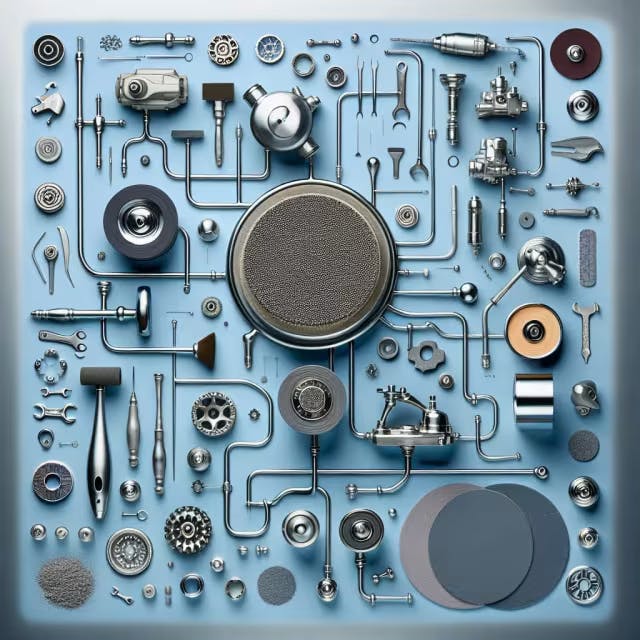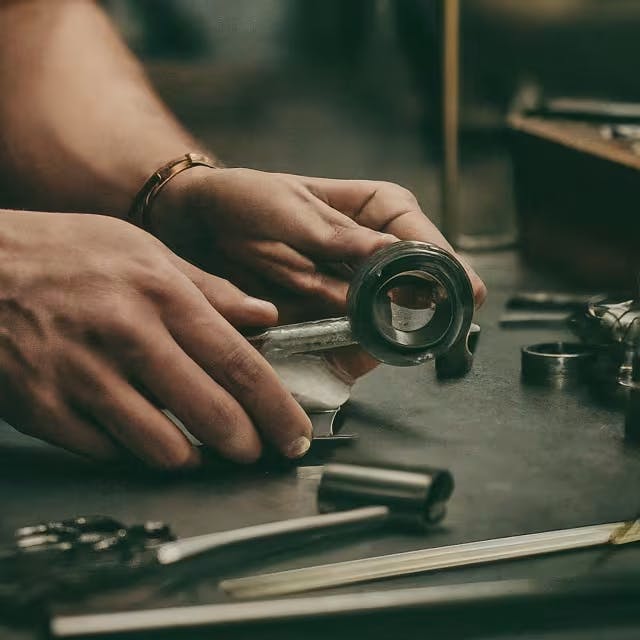Metal Finishing Essentials for a Polished Final Product
Abana Chapter
February 09, 2024

Embarking on the journey of manufacturing entails more than just shaping and assembling; it requires a keen eye for detail, especially when it comes to the final touches. The field of metal finishing is where aesthetics meet functionality, transforming the ordinary into a polished final product that stands the test of time and use. Understanding the metal finishing essentials for a polished final product, from choosing between plating, anodizing, grinding, polishing, buffing, to electropolishing, is pivotal in ensuring durability, resistance to corrosion, and an impeccable appearance.
Key Takeaways
Metal finishing is pivotal for enhancing durability, resistance to corrosion, and improving the aesthetic appearance of the final product.
Various techniques like plating, anodizing, grinding, polishing, buffing, and electropolishing offer different benefits and are chosen based on the desired outcome.
Proper preparation of metals before finishing is essential for achieving superior results, implicating the need for following best practices in the pre-finishing stage.
Achieving both aesthetic and functional excellence in metal finishing requires careful consideration of the chosen method, highlighting the importance of matching the technique to the specific requirements of the product.
Evaluating the quality of metal finishing involves looking at factors such as durability, resistance to corrosion, and the overall appearance, ensuring that the final product meets the desired standards.

Understanding Metal Finishing and Its Importance
Metal finishing is a complex process that ensures the longevity, aesthetics, and functionality of metal products. One key aspect of achieving a high-quality finish is maintaining accurate pH levels throughout the process, including pretreatment, plating, and wastewater treatment. This precision is pivotal for not only enhancing the product's resistance to corrosion and wear but also for adhering to environmental standards. According to Sensorex, precise pH measurements can significantly influence cost control, regulatory compliance, and, ultimately, the quality of the finished metal product. Continuous pH monitoring, facilitated by advanced sensors, plays a crucial role in optimizing the aqueous solutions used in metal finishing processes, ensuring they meet the exact specifications required for high-quality outcomes. For detailed insights on how pH measurement impacts metal finishing, visit Sensorex.

Types of Metal Finishing Techniques for Superior Results
Selecting the right metal finishing technique ensures the durability, aesthetics, and performance of metal products. Various methods cater to different industrial needs and specifications, from enhancing electrical conductivity to improving corrosion resistance.
Electroplating: This process involves using an electric current to coat a metal object with a thin layer of another metal, typically for corrosion protection or aesthetic purposes. It can be used on a wide range of metals and requires precise control over the thickness of the plating layer.
Powder Coating: Offering a durable finish, powder coating applies a protective layer of polymer resin powder to the surface, which is then cured under heat. It is admired for its ability to resist scratching, chipping, and fading.
Anodizing: Specifically for aluminum, anodizing increases corrosion resistance and wearability, while also providing better adhesion for paint primers and glues. The process thickens the natural oxide layer on the surface of metal parts.
Sandblasting: Also known as abrasive blasting, this method cleans and prepares the surface of a metal for painting or coating. By forcefully propelling a stream of abrasive material against the metal, it removes surface contaminants.
For those looking to enhance metal products' looks and lifespan, integrating these essential metal finishing techniques can lead to a polished final product. Each technique comes with its set of advantages, suitability, and application methods, catering to the diverse needs of the industrial sector.
Preparing Metals for Finishing: Best Practices
For achieving a polished final product, it's crucial to ensure that metal surfaces are adequately prepared before finishing. This can significantly impact the quality and durability of the finish. Implementing pollution prevention (P2) practices not only improves the finishing process but also benefits businesses by reducing costs and enhancing worker health and safety. One effective P2 practice is recycling on-site materials, which reduces waste and material costs.
Investing in specialized equipment, like high-efficiency spray guns for autobody shops, can significantly lower overspray and material usage, leading to lower costs and reduced environmental impact. Similarly, for metal finishers, employing rinse water efficiency techniques ensures that less water is wasted, and fewer chemicals are discharged into the environment, aligning with both economic and ecological goals.
For more detailed guidance on incorporating these P2 practices into your operations, assistance is available, providing personalized advice and support for businesses in Washington. This includes help with grant applications to fund necessary improvements or equipment upgrades. Embracing these practices not only contributes to a more sustainable and responsible business model but can also lead to a high-quality, polished final product.
More information on these practices and the support available can be found at Washington State Department of Ecology's website.
Achieving Aesthetic and Functional Excellence in Metal Finishing
Achieving unmatched quality in metal finishes requires attention to both aesthetic and functional aspects. This dual focus ensures not only a visually appealing product but also one that stands up to use and environmental factors. Techniques such as adhesive technology and material research significantly contribute to advancements in this field. For instance, the latest composite resin materials allow for restorations that are both beautiful and durable, highlighting the critical role of innovation in metal finishing.
Orthodontic treatment underscores the importance of proper finishing for optimal occlusal results and stability post-treatment. Using preadjusted edgewise appliances facilitates achieving these goals more precisely. Early goal setting in treatment planning, focusing on occlusal, periodontal, and aesthetic considerations, ensures a tailored approach for each patient.
Beyond medical applications, architectural innovations demonstrate the functional and artistic potential of metal finishes. Insulated metal panels, for example, offer a blend of energy efficiency, aesthetic appeal, and environmental benefits. Projects such as the Metal Architecture Academy in Michigan and Nashville International Airport's new concourse showcase the versatile design possibilities and performance benefits of these materials, as detailed in this discussion on architectural excellence with insulated metal panels.
Understanding these essential techniques and materials will set the foundation for a polished final product that excels in both appearance and functionality.

Evaluating the Quality of Metal Finishing: What to Look For
Evaluating the quality of metal finishing ensures not only the aesthetics of the final product but also its durability and resistance to environmental factors. Here's what to look for to guarantee that your metalwork meets the required standards:
Uniformity: Check for a consistent finish across the entire surface. Any variations can indicate issues with the finishing process.
Smoothness: The surface should feel smooth to the touch, without any rough spots or irregularities.
Visual Inspection: Look for a brilliant sheen or matte finish, depending on the intended result. Discoloration or cloudiness can signal contamination or improper application.
Thickness Measurement: Using specialized tools to measure the coating thickness ensures it meets specifications necessary for durability and performance.
Adhesion Test: A properly finished metal should have a coating that is firmly attached. Techniques such as the tape test can determine the adherence of the finish to the substrate.
Corrosion Resistance: Especially for metals exposed to harsh environments, the finish should provide adequate protection against rust and corrosion.
For a deeper understanding of the techniques and standards involved in metal finishing, consider exploring detailed industry guides and resources, which offer comprehensive insights into ensuring top-quality outcomes. In conclusion, achieving a polished final product through metal finishing requires a comprehensive understanding of the process, from maintaining precise pH levels to selecting the most suitable finishing technique. By prioritizing environmental compliance, cost efficiency, and innovation, manufacturers can ensure their metal products meet the highest standards of aesthetics, durability, and performance. Ultimately, the success of metal finishing lies in the meticulous attention to detail and the relentless pursuit of quality and excellence.
Frequently Asked Questions
How does maintaining accurate pH levels enhance metal finishing processes?
Maintaining accurate pH levels is essential in metal finishing for several reasons. It significantly influences the quality of the finish, ensuring that metal surfaces are prepared and treated correctly, which enhances their resistance to corrosion and wear. Moreover, accurate pH control during the pretreatment, electroplating, and wastewater treatment stages of metal finishing processes is critical for meeting environmental standards. This involves reducing the release of harmful substances into the environment and adhering to regulatory compliance, which not only protects the ecosystem but also reduces potential legal and financial liabilities for businesses. Furthermore, continuous monitoring and adjustment of pH levels using advanced sensors can optimize the efficiency of the aqueous solutions used, leading to cost savings and higher quality outcomes.
What are the key benefits of employing advanced sensors in metal finishing?
Employing advanced sensors in metal finishing encompasses key benefits including:
Enhanced Quality Control: Advanced sensors provide precise pH measurements, crucial for maintaining the specific conditions required for high-quality metal finishing processes such as electroplating, powder coating, and anodizing. This precision ensures the metal products meet desired standards for durability, appearance, and performance.
Cost Efficiency and Regulatory Compliance: Continuous monitoring of aqueous solutions minimizes waste of materials and ensures processes are in compliance with environmental standards. This not only aids in controlling operational costs but also reduces the risk of facing penalties associated with non-compliance.
Optimization of Metal Finishing Processes: By ensuring that each stage of the metal finishing process, from pretreatment to wastewater treatment, is optimized through accurate pH level maintenance, the end products exhibit greater resistance to corrosion and wear, thereby extending their lifespan and enhancing their functional and aesthetic attributes.
Which metal finishing technique is best for improving electrical conductivity?
For improving electrical conductivity in metal finishing, electroplating is the best technique. It involves using an electric current to deposit a thin layer of a metal, such as copper or silver, known for high conductivity, onto the surface of another material. This method not only enhances electrical conductivity but also can provide additional benefits like increased corrosion resistance and improved aesthetic appeal. Ensuring precise control over the plating process, including accurate pH levels and thickness of the plating layer, is crucial for achieving the desired conductivity and quality of the finish.
Why is powder coating admired for its durability?
Powder coating is highly admired for its durability due to its unique application and curing process, which creates a hard finish that is tougher than conventional paint. Unlike liquid finishes, powder coating doesn't run or drip, providing a more uniform finish even on surfaces with complex shapes. This method is effective in resisting scratching, chipping, fading, and wear, making it an excellent choice for both functional and aesthetic purposes in various industries. In addition, its efficiency, environmental friendliness due to the lack of volatile organic compounds (VOCs), and the ability for thicker coatings without compromising texture or quality further contribute to its reputation for durability.
How does anodizing benefit aluminum products specifically?
Anodizing specifically benefits aluminum products by enhancing their corrosion resistance and wearability, which prolongs their usable life and maintains their appearance over time. This process thickens the aluminum's natural oxide layer, making it more resistant to environmental damage and daily wear. Additionally, anodized aluminum surfaces offer improved adhesion for paint primers and glues compared to untreated aluminum, facilitating further customization and ensuring coatings adhere more effectively and last longer.
What role does pollution prevention practices play in achieving a polished final product?
Pollution prevention practices play a vital role in achieving a polished final product by enabling more efficient and environmentally responsible metal finishing processes. Through techniques such as recycling on-site materials, employing rinse water efficiency, and using high-efficiency spray equipment, these practices reduce waste, minimize environmental impact, and lower operational costs. By integrating pollution prevention into the workflow, manufacturers not only adhere to regulatory standards but also enhance the durability, aesthetics, and overall quality of the final metal products, ensuring better performance and longer lifespan.


